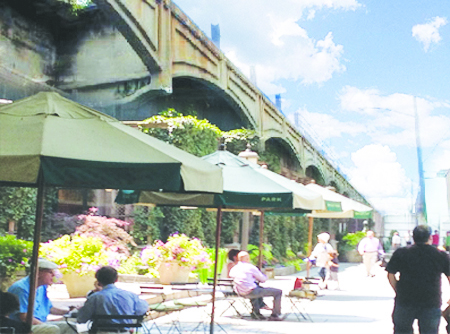
An artists rendering of what visitors to the proposed Queensway will have to look forward to. This projection for a restaurant is just on feature of the planned beautification project.
An elevated public park may be in the future for a 3.5 mile stretch of abandoned railroad track on the old LIRR Rockaway Beach Branch as the environmental group working on the project put out a call for companies to help with the design and feasibility study.
Last Week, the Trust for Public Land (TPL), a national land conservation organization based in San Francisco, issued a formal request for proposals seeking a company with substantial experience in “community collaborations” to carry out the feasibility study for the project.
The TPL, which has strong experience in other “rails-to-trails” conversions, is working with the locally-based Friends of the Queensway (FQW) to help make the project a reality. The FQW is a group that supports converting the stretch of the Rockaway Beach Branch which runs from Rego Park and Forest Hills to Ozone Park into “High Line-style” parkland for bikers, hikers, joggers and tourists.
The former rail line, which has been abandoned since 1962, has become home to broken bottles and other litter and has turned into a major community eyesore, suffering from years of neglect by the city.
Marc Matsil, New York State Director for the Trust for Public land, said once a company is selected, the feasibility study could be completed within a year.
The study, said Matsil, will include various tests of the land’s soil and groundwater in addition to examination of the bridges by engineers to test for structural integrity as well as estimates of associated costs to turn the elevated line into a linear park.
Matsil also noted that the new park would serve 250,000 residents who live within one mile while providing a significant economic boost to the borough.
He also emphasized there’s a “tremendous amount of community support” for the project, noting that FQW now has more than 3,000 supporters. “Our goal is that we want to work with the community,” said Matsil, noting that one of the hallmarks of TPL is community visioning. “We’ve done a number of greenways and waterfront plans in the past,” he said.
Matsil said they’ve reached out to a number of firms nationally to encourage them to submit plans for the project. Typically, firms which specialize in landscape architecture and urban design submit proposals for such plans.
Fundraising for the project is ongoing and to date includes close to $1 million from various public and private sources including a $467,000 grant last year from the state and a recent donation from the Tiger Baron Foundation.
But, while Matsil notes there is strong support for the project, there is also considerable opposition as well.
Mainly, that opposition comes in the form of homeowners who live near the proposed park in Rego Park, Forest Hills and Ozone Park and from transit advocates who want to see the Rockaway Beach LIRR line reactivated.
Rockaway Assemblymen Phil Goldfeder and Mike Miller have expressed support for a reactivated Rockaway line.
For the opposing homeowners, Matsil notes that the park will be a boon to the local economy and will help bolster real estate resale values. Homeowners have expressed concern that a park will bring excessive noise and safety issues. And, those same homeowners are largely against a new rail line as well.
Reactivation of the Rockaway rail line, said Matsil, is not very likely due to the exorbitant costs that are associated with any such project.
For his part, Matsil said the real cost of railroad activation could be as high as $3 billion as opposed to some other recent estimates which have been less than $1 billion. “There are not too many entities out there in position to spend that kind of money,” he said.
And, City Council Member Karen Koslowitz (D-Forest Hills) was quoted in recent press reports as saying that reactivation of the Rockaway line would come only “over her dead body.”
“I think that ultimately property becomes much more valuable when you’re located near parkland,” Matsil said. “I’m not so sure that is the case with property near a railroad track.”
By Alan Krawitz
